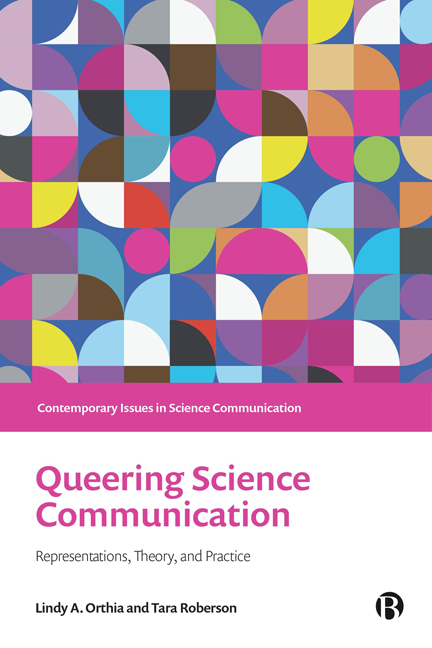Book contents
- Frontmatter
- Contents
- Series Editor Preface
- Notes on Contributors
- Acknowledgements
- Terminology and Sensitive Content in This Book
- Introduction
- PART I Negotiating Queer Identities with Science, Technology, and Medicine
- PART II Representations of Queerness in Public Science Communication
- PART III Queer People in Science Communication Communities
- PART IV Queering Institutional Science Communication Agendas
- Conclusions
- Index
3 - Queer Interests in Technology and Innovation Discourse
Published online by Cambridge University Press: 18 January 2024
- Frontmatter
- Contents
- Series Editor Preface
- Notes on Contributors
- Acknowledgements
- Terminology and Sensitive Content in This Book
- Introduction
- PART I Negotiating Queer Identities with Science, Technology, and Medicine
- PART II Representations of Queerness in Public Science Communication
- PART III Queer People in Science Communication Communities
- PART IV Queering Institutional Science Communication Agendas
- Conclusions
- Index
Summary
Technology plays a significant role in our lives. Dominant narratives for technology might centre on the benefits, but for queer people the opportunities afforded by technology are counterbalanced by the consequences.
As a younger queer person, access to the information and social networks available through the Internet played a key role in my self-discovery. I vividly remember searching the web using different queer identities as keywords (lesbian, gay, bisexual, queer) while completing online web surveys which promised to concretely label my identity and hesitating over the selection of ‘who I was interested in’ while adding to my Facebook profile. Through the family computer and ADSL, I possessed an avenue for finding out what it meant to be queer while existing in a largely heteronormative world. This combination of technology and networks meant access to social groups, ways to find other people like me. Today it still serves that purpose by helping me communicate with and join people who are organizing social movements for LGBTIQA+ communities. Yet, my public ‘out’ presence also poses risks that I am mindful of, particularly when it comes to global travel (Equaldex, 2022; ILGA, 2020).
The pervasive and powerful presence of different technologies can be both a boon and a problem. This means science communicators who work with and through technologies need to be critically awake to the implications of their use. Here, I explore the impact technologies have on queer people and voices. I consider how queer voices might be added into the technology and innovation creation and use discourse. The underlying motivation of this work parallels Emily Dawson's (2019) eloquent articulation as to why science communication should learn to value differences instead of minimizing and erasing them. In her book on ‘race’ and informal science learning, Dawson says that as people who feel included in science and technology worlds, science communicators and associated professionals ‘have a responsibility to centre social justice in our work. If we do not, we have to ask serious questions about whether we are happy to reproduce advantages for dominant groups at the expense of the minoritised’ (Dawson, 2019, p 159). Here, I apply this lesson to technology and innovation discourse and consider what communication looks like when equity, diversity, and inclusion are centred, rather than given lip service (Yep, 2003).
- Type
- Chapter
- Information
- Queering Science CommunicationRepresentations, Theory, and Practice, pp. 48 - 68Publisher: Bristol University PressPrint publication year: 2023



